RESEARCH ARTICLE
Influence of Seashell on the Physical, Mechanical, and Thermal Properties of Brick Mortar Mixtures
Mohamed Lemine Mohamed Essalem1, Toufik Cherradi1, Sofiane Amziane2, Mohamed Cheikh Teguedy3, *
Article Information
Identifiers and Pagination:
Year: 2023Volume: 17
E-location ID: e187414952301120
Publisher ID: e187414952301120
DOI: 10.2174/18741495-v17-e230113-2022-69
Article History:
Received Date: 12/10/2022Revision Received Date: 13/12/2022
Acceptance Date: 22/12/2022
Electronic publication date: 31/01/2023
Collection year: 2023

open-access license: This is an open access article distributed under the terms of the Creative Commons Attribution 4.0 International Public License (CC-BY 4.0), a copy of which is available at: https://creativecommons.org/licenses/by/4.0/legalcode. This license permits unrestricted use, distribution, and reproduction in any medium, provided the original author and source are credited.
Abstract
Background:
This work investigated the effect of crushed cockle shell (CCS) and mixed seashell (MS) as shell sand in cement hydraulic lime brick mortar. The seashells aggregates came from the shell middens of Mauritania.
Objective:
This study aims to valorize seashell waste in mortar brick mixes, to design a light insulating brick.
Methods:
The seashells were heat treated at 105°C for 6h, then crushed and sieved into shell sand. Then, they were studied by X-ray diffraction (XRD), thermogravimetric analysis (TGA), and specific tests for mortar aggregates. Afterward, several mortar bricks were fabricated by replacing the natural sand with shell sand. The physical, mechanical, and thermal properties of the produced bricks were compared with two types of natural mortar bricks. In total, six types of masonry bricks were produced. The properties analyzed were the compressive strength, flexural strength, water absorption, bulk density and bulk porosity, thermal conductivity, and thermal resistance of the bricks.
Results:
It was observed that the use of seashell waste increased the porosity and water absorption of the bricks and decreased the bulk density and mechanical strength.
Conclusion:
It is concluded that the seashell shape promotes the porosity of the mortar bricks, making them more insulating and lighter. Characterizing crushed cockle shells (CCS) and mixed seashell (MS) bricks help clarify the field and limits of application of these bricks.
1. INTRODUCTION
Mauritania's environment is hot and humid, with an average annual maximum temperature of 35.2 °C. About two-thirds of the total electricity produced in Mauritania is needed to maintain acceptable living conditions in buildings [1]. Available data shows that energy consumption reached approximately 1111.796 GWh in 2019. The annual increase in energy consumption averaged 7% between 2017 and 2019 and 35% during the summer months [1].
The increase in energy consumption is mainly due to the air conditioning in residential buildings. This invites the development of low-cost thermal insulation materials that could reduce energy consumption in residential buildings. Globally, several efforts are directed toward optimizing energy resources [2, 3]. One of these directions is to use thermally efficient low-cost building materials in the construction sector to minimize electricity consumption [4, 5]. The load due to thermal transmission through the building envelope (walls and roof) constitutes a significant percentage of the total thermal load [6, 7]. Therefore, an appropriate selection of building materials for masonry could significantly reduce this load.
In construction, mortar bricks are widely used in Mauritania. These masonry bricks provide poor thermal insulation in building construction. The development of low-cost thermally insulating materials can improve the thermal insulation of these masonry bricks. In this context, recycling and using local materials can be an alternative [8]. Several recycled waste has been incorporated into mortars to produce bricks with high thermal insulation [9]. The results show that incorporating these wastes reduces the thermal conductivity of the bricks, which results in better insulation of the building enclosure.
On the other hand, the lack of natural sources of aggregates needed in the field of construction has led to the use of seashells from the shell middens of Mauritania as aggregates in cement materials structures [10], including residential houses, septic tanks, masonry structures, and pavement slabs. Many different types of seashells have built up into these middens, but no studies or regulations govern their use.
Globally, seashells are one of the wastes that accumulate rapidly, especially in coastal areas and countries that consume many seafood products. For example, 17.5 million tons of shellfish are produced each year (FAO, 2019) [11].
The use of seashells as aggregates and sand substitutes in mortar has motivated several studies [12-15]. Others have replaced Portland cement with crushed seashells by weight as binders in the mortar [16]. The overall results showed that the mechanical and physical properties of mortar are affected by the size and type of seashell used.
However, little literature is available on the thermal insulation properties of seashell aggregate mortar. Lertwattanaruk et al. [16] observed that incorporating seashells as a partial replacement material in cement mortar decreases the thermal conductivity of the mortar. High porosity was given as a reason for the decreased thermal conductivity. The addition of seashells decreases the thermal conductivity of mortar by 1 to 45%. These authors concluded that shell-based materials have, in general, a very high porosity and water absorption capacity, which invites their use in cementitious materials to decrease their thermal conductivity.
This study aims to valorize seashell waste in mortar brick mixes to design a light-insulating brick. The first step is to study the physical and mechanical properties of shell-based mortar bricks, such as flexural strength, compressive strength, water absorption, bulk density, and bulk porosity. The next step is to evaluate the thermal performance of shell-based mortar bricks. The evaluation includes studying the effects of mortar types on the thermal conductivity and thermal resistance of the bricks. These data types are not widely available and will be useful for selecting brick construction materials for buildings.
2. MATERIALS AND METHODS
In this work, Portland cement (CEM II 32.5), hydraulic lime (N 3.5) Table 1, natural sand, and shell sand were used (Fig. 1). The sands used were natural sand (NS) with a fraction of 0-4 mm (Fig. 2). The two shells sands were prepared:
| Binder | Particle Density (g/cm3) | Blaine Fineness (cm2/g) |
|---|---|---|
| Portland Cement | 3.15 | 3170 |
| Hydraulic Lime | 2.58 | 9623 |
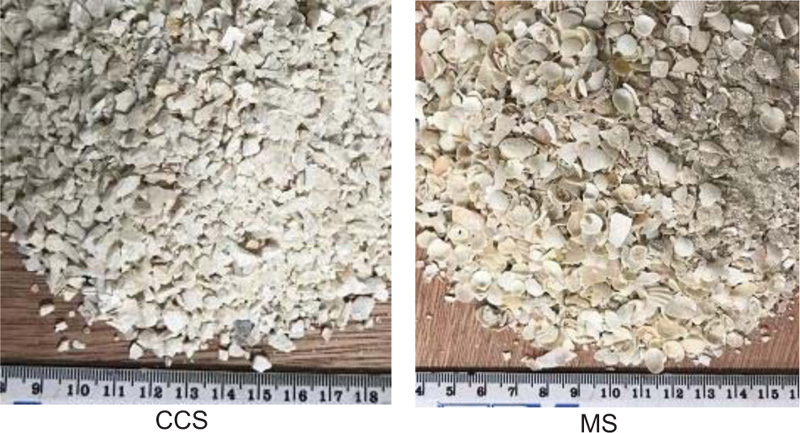 |
Fig. (1). Seashell aggregates. |
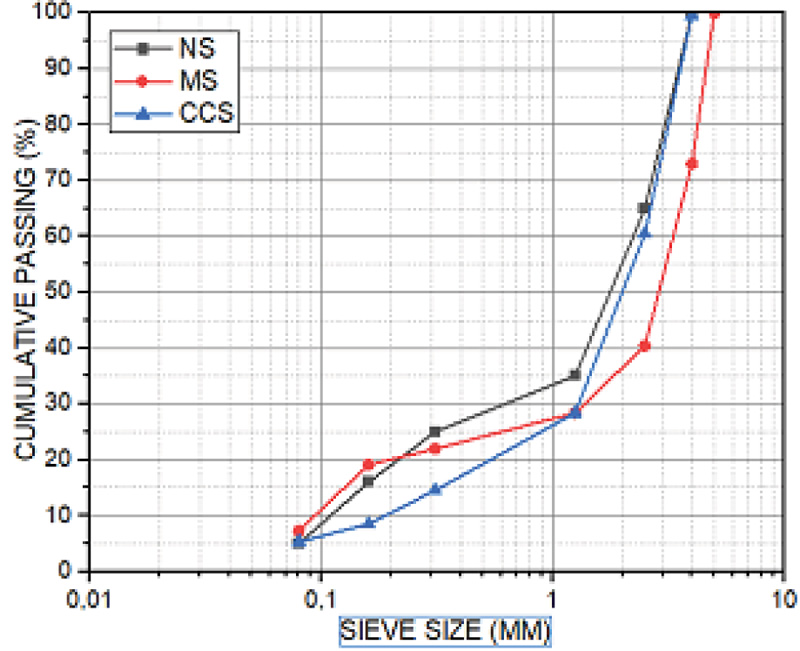 |
Fig. (2). Granulometric analysis of aggregates. |
- Crushed cockle shell sand to a fraction of 0-4 mm (CCS (0-4)).
- Mixed shell sand to a fraction of 0-5 mm (MS (0-5).
The seashells were washed with water to remove all traces of impurities. Then, they were dried in an oven at 105° for 6 h. All the properties of the aggregates were analyzed. The results are presented in Table 2.
| Properties | NS | MS | CCS |
|---|---|---|---|
| Fineness modulus | 1.81 | 2.5 | 1.95 |
| Bulk density (kg/m3) | 1500 | 899 | 1450 |
| Specific gravity | 2.200 | 2.350 | 2.270 |
| Water absorption (%) | 3.5 | 9.73 | 3.43 |
In total, six different batches of mortar were formulated, with a mass of 4 kg each (cf. Table 3). Each mortar produced 6 samples of parallelepiped bricks (4 × 4 × 16 mm) with 36 samples. After casting, the samples were wet-cured for 28 days. After this process, the samples were left in a drying oven at 50 °C for 48 h (cf. Fig. 3).
| Brick Mortar |
Cement (g) |
Lime (g) |
NS (g) |
MS (g) |
CCS (g) |
Water (g) |
|---|---|---|---|---|---|---|
| Type-A (reference) | 300 | -- | 1600 | -- | -- | 180 |
| Type-A1 | 300 | -- | -- | -- | 1600 | 180 |
| Type-A2 | 300 | -- | -- | 1600 | -- | 180 |
| Type-B (reference) | -- | 400 | 1500 | -- | -- | 260 |
| Type-B1 | -- | 400 | -- | -- | 1500 | 260 |
| Type-B2 | -- | 400 | -- | 1500 | -- | 260 |
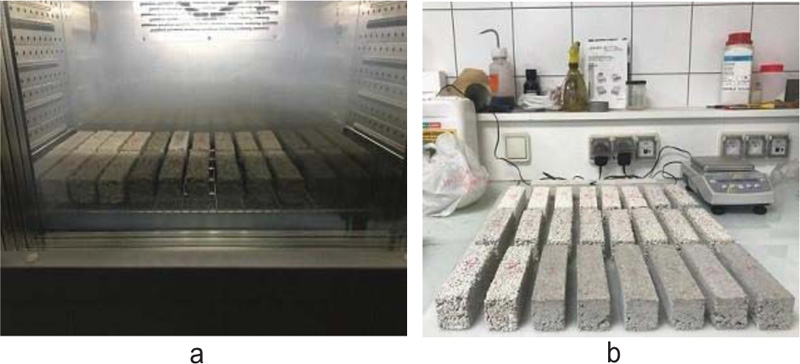 |
Fig. (3). During the drying process (a); Brick samples (b). |
The physical properties of the bricks were measured by the Archimedes method according to the ASTM C20 [17]. In this process, dry weights, suspension weights, and saturation weights of the samples were measured, and these values were used to calculate apparent porosity, water absorption, and bulk density according to (1-3) [18].
 |
(1) |
 |
(2) |
 |
(3) |
The compressive and flexural strengths of the samples were measured according to ASTM C109 / C109M [19] and ASTM C348 [20] (Fig. 4).
The thermal behavior of the brick samples was characterized by the hot-wire method according to ASTM C518 [21], which estimates the thermal conductivity of a material from the evolution of the temperature measured by a probe consisting of a thermocouple placed near a resistive wire. The probe is positioned between two samples of the material to be characterized. By signal processing integrated with the software provided, the identification of the thermal conductivity is performed (cf. Fig. 5). The thermal resistance (R) is deduced from (4).
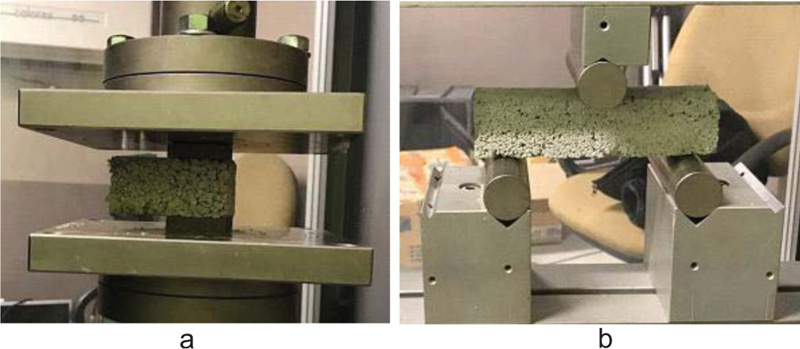 |
Fig. (4). Mechanical setup to determine: (a) compressive strength and (b) flexural strength of the samples. |
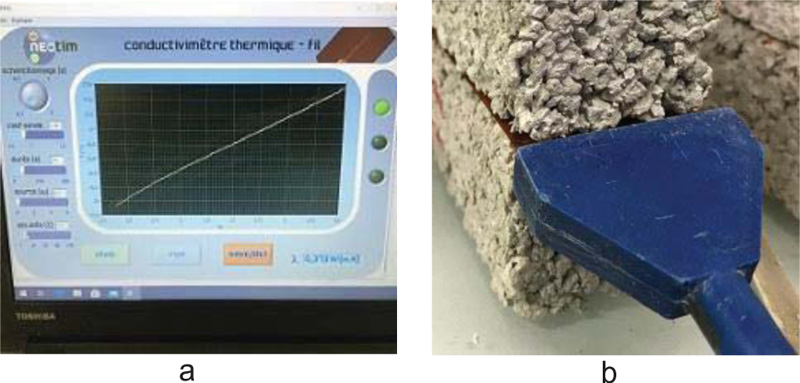 |
Fig. (5). Thermal conductivity test. (a) provided software (b) Hot wire probe. |
 |
(4) |
With
R: the thermal resistance (in m2.K/W);
E: the thickness (expressed in meters);
λ: thermal conductivity of the material (W/m.K).
3. SEASHELL CHARACTERIZATION
Most mollusk shells comprise 95-97% calcium carbonate (CaCo3) with several chloride ions and sulphates [22]. The seashells are formed by biomineralization of CaCO3, with a small amount of organic matrix which holds the structure together [22].
The crystal phase content of the seashell was determined by an X-ray diffraction pattern (Fig. 6). The main seashell phases were determined to be aragonite (CaCO3) phases.
The mass change characteristics of the seashell depending on the temperature were analyzed by a Perkin Elmer STA8000 instrument. These analyses were carried out under a nitrogen atmosphere and at a constant heating rate of 10 °C/min to 950 °C. The TGA result of the seashell is illustrated in Fig. (7). It can be observed that about 41% of the total mass of the seashell decreases at 950 °C. Considering the physical infrastructure of this mass loss, it can be said that the total weight loss at 100 °C is caused by the evaporation of physical water, which is about 1%. The mass loss between 150 and 550 °C due to the calcination of organic matter is about 2%, and the mass loss associated with the decomposition of CaCO3 to CaO (endothermic reaction) between 600 and 800 °C is about 37%.
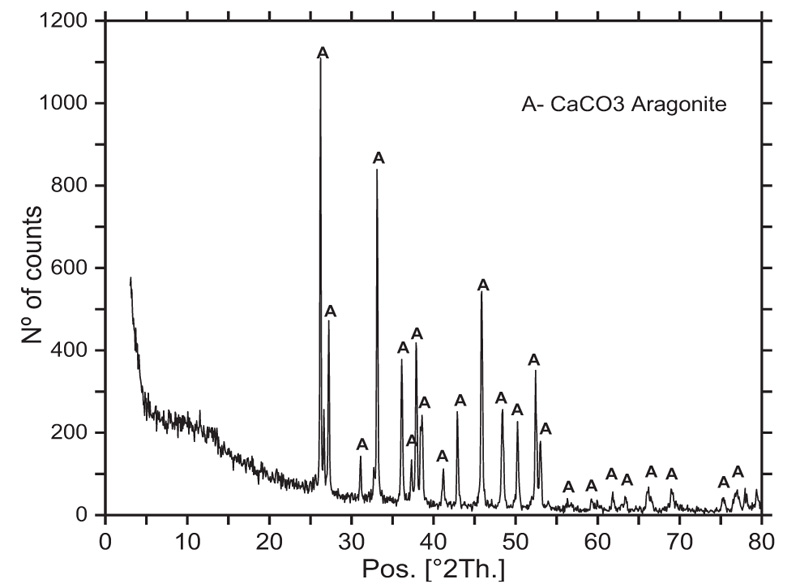 |
Fig. (6). XRD pattern of seashell |
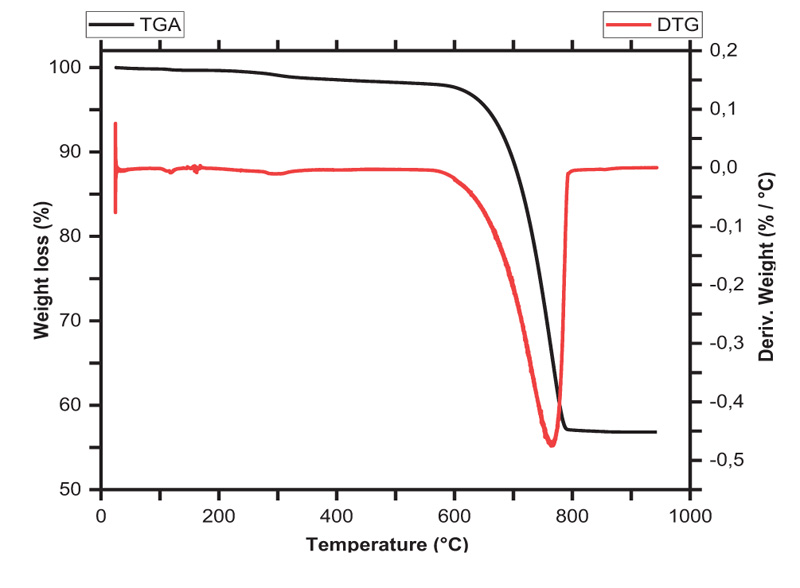 |
Fig. (7). TGA results of seashell |
4. RESULTS AND DISCUSSION
The porosity values of the produced bricks are presented in Fig. (8). The porosity of the brick is presented according to the types of mortar. Its values vary between 20% and 28%. The apparent porosity of the reference brick (Type-A) was 23.9%. It is decreased by 16% when a crushed cockle shell is used (Type-A1). When mixed shell sand was added, the brick's porosity (Type-A2) was increased by 17% compared to the Type-A brick. The increase in porosity of Type-A2 brick is largely attributed to the higher water absorption of mixed shell compared to natural sand and crushed cockle shell (MS has 400% and 300% higher water absorption capacity than NS and CCS, respectively). However, using hydraulic lime as a binder for the brick mortar increases the porosity. The porosity of Type-B brick was increased by 7% compared to Type-A brick, but when the mixed shell was added, brick based on cement and mixed shells had a better performance in terms of porosity. Finally, it can be seen that using mixed shell sand results in brick with a high porosity which is desirable for increasing the thermal performance.
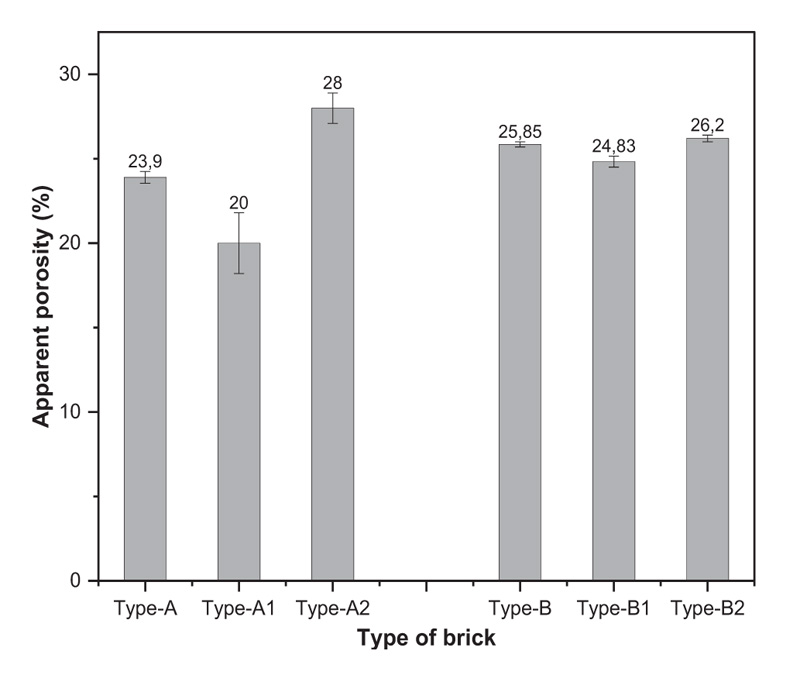 |
Fig. (8). Apparent porosity variations of bricks. |
The bulk density values of the produced bricks are presented in Fig. (9). It can be observed that the bulk density of the brick is between 1.35 and 1.91 g/cm3. The hydraulic lime-based brick (type B) has a higher bulk density than the cement-based brick (type A). The bulk density of Type-B brick is 7% higher than Type-A brick. The bulk density of the brick shows a decreasing trend when mixed shell sand is added; type-a2 brick showed a 19% reduction compared to Type-A, while Type-B2 is 16% lower compared to Type-B. These reductions can be attributed to the angular and irregular shape of the seashell and the presence of organic substances, creating more air trapped in the brick body. On the other hand, adding crushed cockle sand slightly increases the bulk density of Type-A bricks. The increase in bulk density of Type-A1 is 5% compared to Type-A bricks, while that of Type-B1 is 7% compared to Type-B bricks.
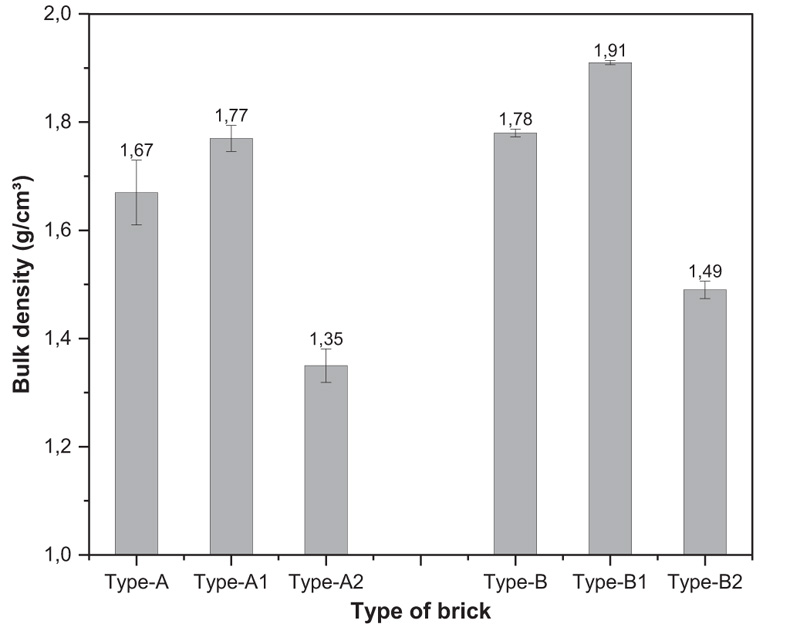 |
Fig. (9). Bulk density variations of bricks. |
The bricks based on seashell sand have a low apparent density, so the dead load of the walls of these bricks will decrease, which implies the reduction of the cross sections of the structure while reducing the cost of construction.
The water absorption variations of the produced bricks are given in Fig. (10). The water absorption of the bricks varies between 12% and 22.5%. The lowest absorption value of 12% belongs to the Type-A1 brick, with the lowest porosity and the highest density compared to the Type-A-based brick. The highest water absorption value, 22.5%, is observed in the Type-A2 brick, which has the highest porosity and lowest density. As seen here, there is a closely related to the water absorption, bulk density, and porosity of mortar bricks. The relation is illustrated in Fig. (11).
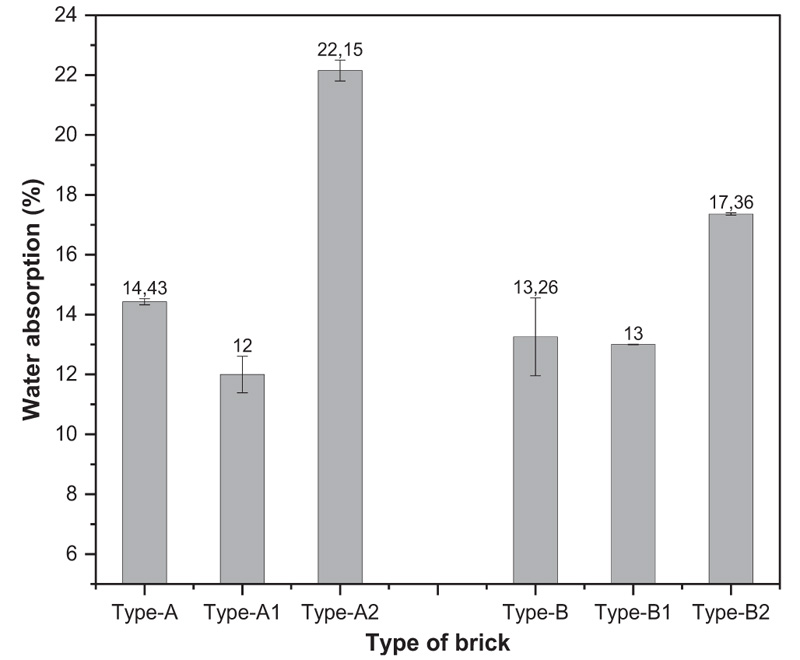 |
Fig. (10). Water absorption variations of bricks. |
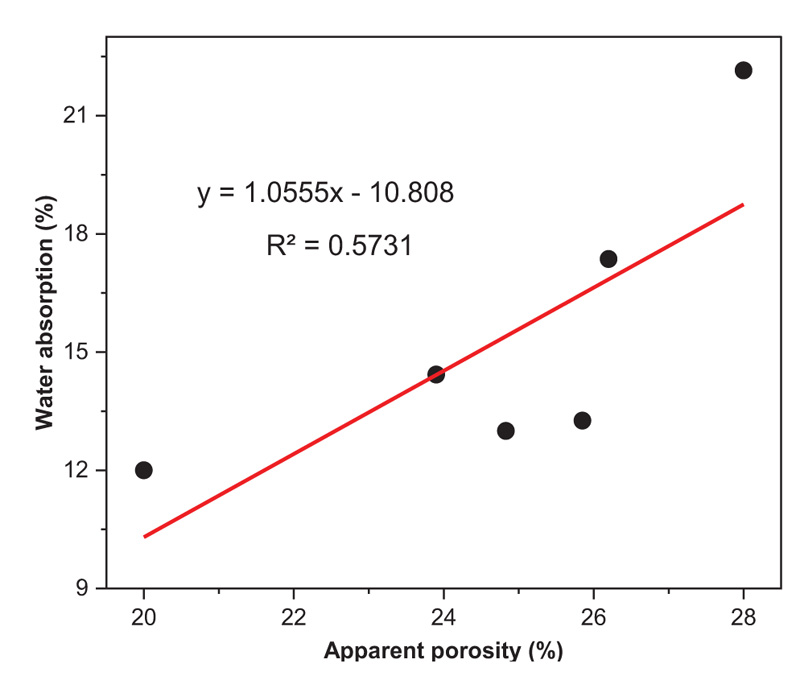 |
Fig. (11). Relationship between porosity and water absorption of bricks. |
The variations in the compressive strength of the bricks produced are given in Fig. (12). The compressive strength shows a decreasing trend when mixed shell sand is used. The loss in strength of type-A2 brick is 400% compared to type-A. However, the strength increases slightly when crushed cockle shell sand is incorporated. The reason is that adding a mixed shell increases the porosity of the brick. When the porosity increases, the compressive strength behaves oppositely. On the other hand, when the crushed cockle shell is used, the porosity of the brick decreases, increasing strength. A close relationship between compressive strength and porosity can be established, as shown in Fig. (13). This relation is pretty high, with R2 = 0.97.
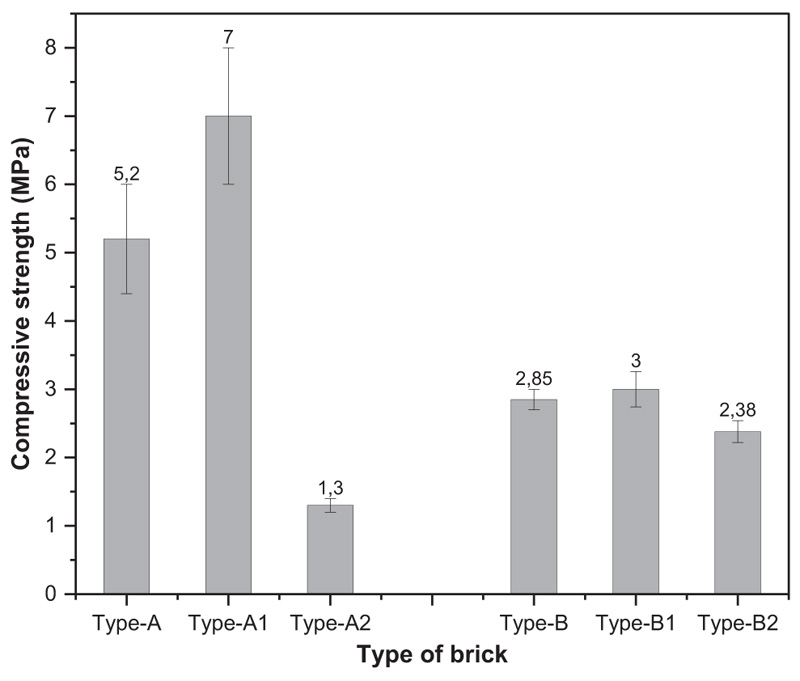 |
Fig. (12). Compressive strength variations of bricks. |
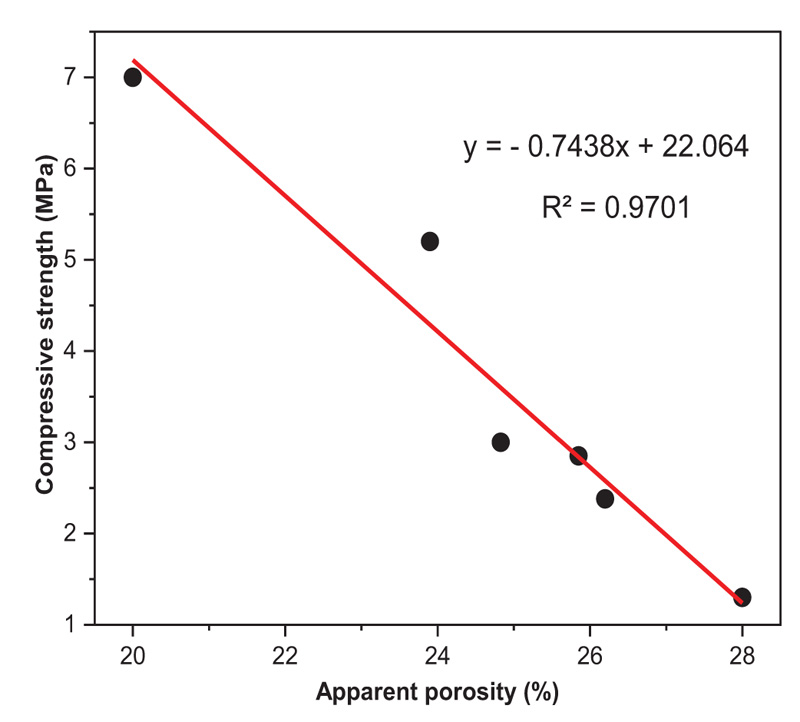 |
Fig. (13). Relationships between porosity and compressive strength. |
Finally, it was noted that the brick Type-A1 has sufficient compressive strength according to the code that requires a minimum strength value for masonry brick (NF EN 771-3). On the other hand, the bricks based on the MS (Type-A2) have a strength slightly lower than the minimum required value (The average normalized compressive strength of a masonry unit is not less than 2 MPa) [23]. The improvement of the resistance of this type of brick to reach the minimum required value is possible with the use of more resistant cement.
Fig. (14) shows the changes in flexural strength as a function of brick types. The compressive strength values of the bricks vary between 0.4 MPa and 2 MPa. The variations in the results are similar to that of the compressive strength. The flexural strength increases when a crushed cockle shell is used and decreases with mixed shell sand.
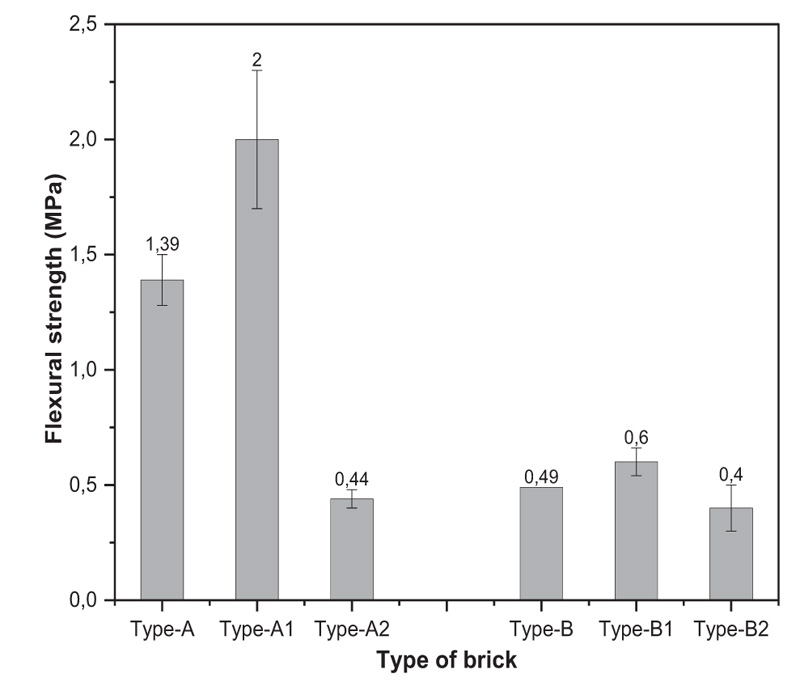 |
Fig. (14). Flexural strength variations of bricks. |
The thermal conductivity values of the produced bricks vary between 0.301 W/mK and 0.582 W/mK (Fig. 15). Using shell sand in brick mortars decreases the thermal conductivity values of the produced bricks, which means that the thermal insulation performance of the brick increases. The thermal conductivity value of a brick containing mixed shell (Type-A2) decreases by up to 33% compared to the same brick containing natural sand (Type-A). This is attributed to the porosity of the brick, as shown in Fig. (16). The thermal conductivity value decreases as the porosity of the brick increases.
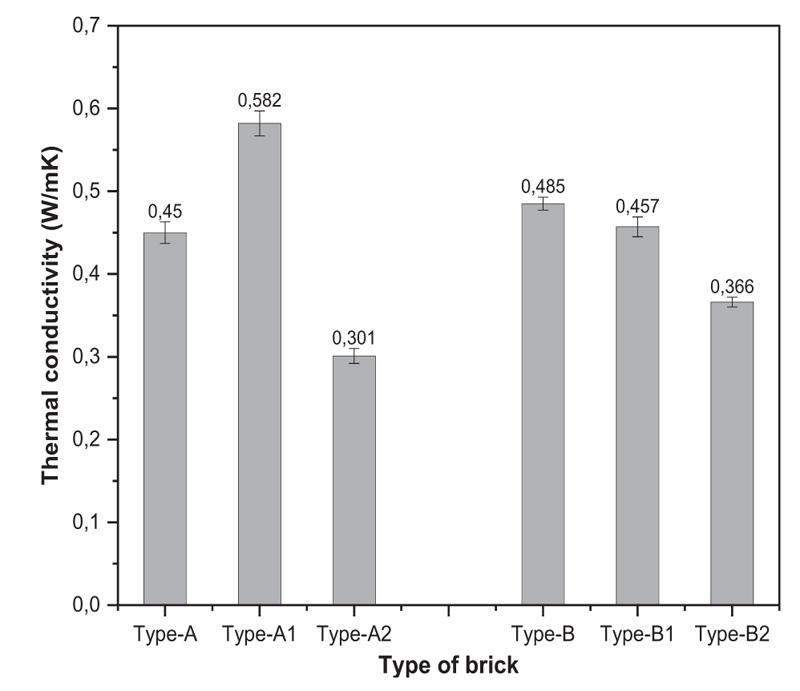 |
Fig. (15). Thermal conductivity variations of bricks. |
The lower thermal conductivity values present more comfortable living areas in the building. The thermal conductivity of mixed shell cement mortar bricks is 0.301; this implies very high thermal insulation compared to the brick based on natural aggregates. These results show that seashell sand can be used as a new thermal insulation material in brick production.
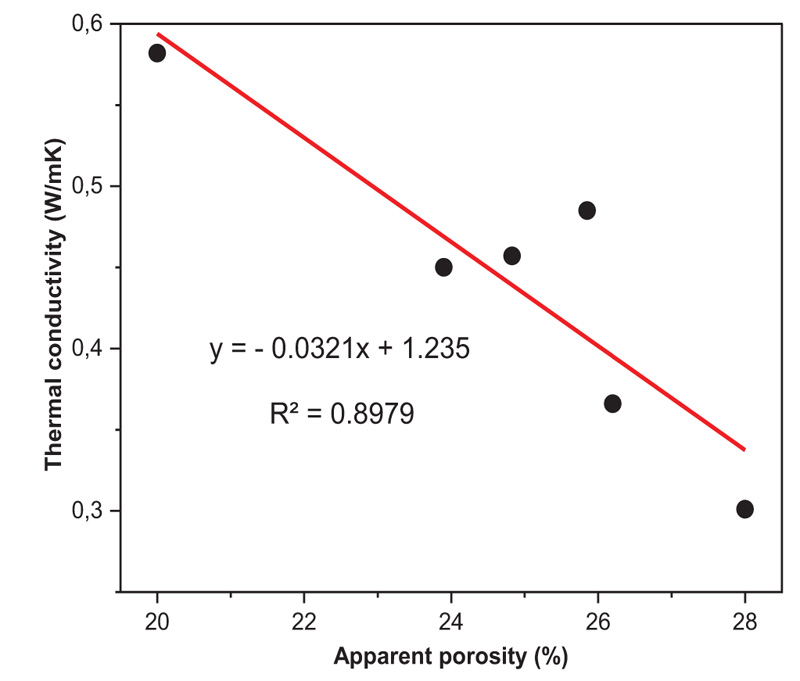 |
Fig. (16). Relationships between porosity and thermal conductivity of bricks. |
Fig. (17) shows the thermal resistance values for the 20 cm thick brick samples as a function of mortar types. The variations in the results are inversely proportional to those of the thermal conductivities. The thermal resistance of the bricks increases when crushed cockle shell is used and decreases with the use of mixed shell sand. The results show that the type-A2 brick is more efficient than the other types.
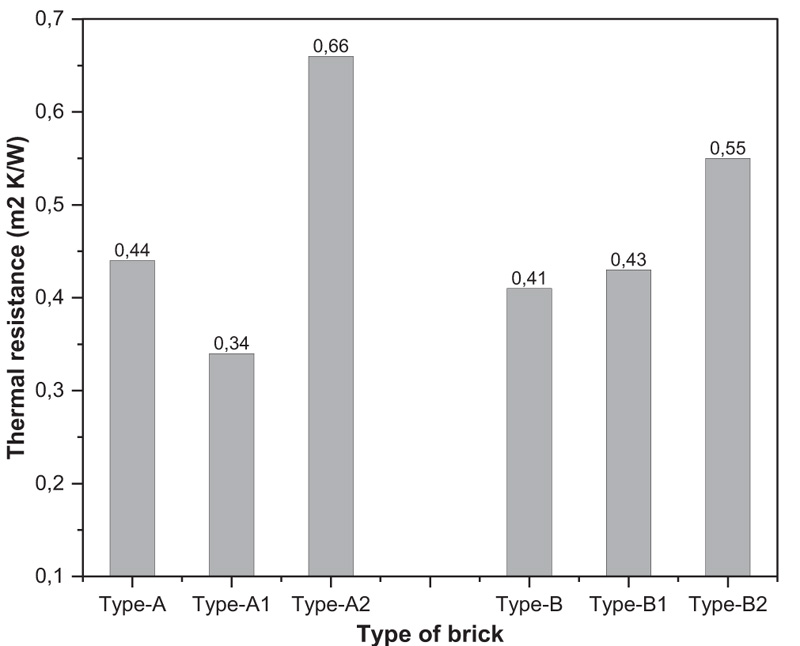 |
Fig. (17). Thermal resistance variations of bricks. |
CONCLUSION
Two types of shell sands were incorporated into cement and hydraulic-lime mortar. Six types of masonry bricks were produced. The physical, mechanical, and thermal properties of the bricks were obtained. The following conclusions can be drawn:
- Using seashell waste allows the production of bricks with a high porosity of up to 28%. Adding MS increased the porosity by about 17% compared to the reference. Porosity is the main characteristic of the brick that affects its technical and thermal properties of the brick.
- Bulk density is decreased with the addition of mixed shell sand, while it increases slightly when using crushed shell sand.
- The compressive strength of bricks containing CCS is 7 MPa. According to the code, these bricks have sufficient compressive strength, which requires a minimum strength value for masonry brick. On the other hand, the bricks containing mixed shell sand (MS) have a strength slightly lower than the minimum required value. As expected, there is a linear relationship between compressive strength and porosity, which is observed in work.
- The use of MS decreases the value of the thermal conductivity of bricks due to the increased porosity. The thermal conductivity of type-A2 brick decreases by about 42%, and the thermal resistance increases by 50%, which means better thermal insulation in building construction.
- The micro-porous structure formed in the body of the brick due to the addition of the seashell affects the properties of the brick. The seashell shape favors the porosity of the mortar bricks, making them more insulating and lighter.
Finally, it is recommended to use cockle shell sand (CCS) to produce bricks for structural application, while mixed shell sand (MS) is for thermal insulation only. Mixed seashells can be used to create alternative porosity in the production of lightweight insulating bricks.
LIST OF ABBREVIATIONS
| NS | = Natural Sand |
| CCS | = Cockleshell Sand |
CONSENT FOR PUBLICATION
Not applicable.
AVAILABILITY OF DATA AND MATERIALS
The data and supportive information are available within the article.
FUNDING
None.
CONFLICT OF INTEREST
The authors declare no conflict of interest, financial or otherwise.
ACKNOWLEDGEMENTS
Declared none.
REFERENCES
| [1] | ANSADE, ANSADE Mauritania. Annual statistical report, 2021. Available from: https://ansade.mr/fr/ |
| [2] | S. Lechtenböhmer, and A. Schüring, "The potential for large-scale savings from insulating residential buildings in the EU", Energy Effic., vol. 4, no. 2, pp. 257-270, 2011. |
| [3] | J. Nyers, L. Kajtar, S. Tomić, and A. Nyers, "Investment-savings method for energy-economic optimization of external wall thermal insulation thickness", Energy Build., vol. 86, pp. 268-274, 2015. |
| [4] | E.H. Ahmad, "Cost analysis and thickness optimization of thermal insulation materials used in residential buildings in Saudi Arabia", 6th Saudi Eng. Conf. KFUPM, Dhahran, December 2002, vol. 1, 2002pp. 21-32 |
| [5] | S. Schiavoni, F. D’Alessandro, F. Bianchi, and F. Asdrubali, "Insulation materials for the building sector: A review and comparative analysis", Renew. Sustain. Energy Rev., vol. 62, pp. 988-1011, 2016. |
| [6] | U. Berardi, and M. Naldi, "The impact of the temperature dependent thermal conductivity of insulating materials on the effective building envelope performance", Energy Build., vol. 144, pp. 262-275, 2017. |
| [7] | O. Mrajji, S. Ouhaibi, F. Bianchi, M.E. Wazna, A.E.L. Bouari, B. Naoual, Ezzine M., R.L.R Lbibb, R.L.R Lbibb, and O. Cherkaoui, "Experimental and numerical investigation of eco-friendly materials for building envelope", Adv. Build. Energy Res., vol. 16, no. 3, pp. 1-24, 2021. |
| [8] | "A review of unconventional sustainable building insulation materials,”", Sustain. Mater. Technol., vol. 4, pp. 1-17, 2015. |
| [9] | P. Muñoz, M.P. Morales, M.A. Mendívil, M.C. Juárez, and L. Muñoz, "Using of waste pomace from winery industry to improve thermal insulation of fired clay bricks. Eco-friendly way of building construction", Constr. Build. Mater., vol. 71, pp. 181-187, 2014. |
| [10] | G. Irene, "Tests on Mortars and Concrete Made With Seashells As Agregate. Case Study in Mauritania Nocmat 2009", 11th Int. Conf. Non-conventional Mater. Technol. NOCMAT 2009, 2009pp. 6-9 |
| [11] | FAO, Available from: http:// www.fao.org/fishery/statistics/global-aquaculture-production/query/es |
| [12] | H. Yoon, S. Park, K. Lee, and J. Park, "Oyster shell as substitute for aggregate in mortar", Waste Manag. Res., vol. 22, no. 3, pp. 158-170, 2004. |
| [13] | "Effect of waste oyster shell resurgent on engineering properties of cement mortar", 2011 International Conference on Consumer Electronics, Communications and Networks, CECNet 2011 - Proceedings, 2011 |
| [14] | B. Safi, M. Saidi, A. Daoui, A. Bellal, A. Mechekak, and K. Toumi, "The use of seashells as a fine aggregate (by sand substitution) in self-compacting mortar (SCM)", Constr. Build. Mater., vol. 78, pp. 430-438, 2015. |
| [15] | W-T. Kuo, H.Y. Wang, C.Y. Shu, and D.S. Su, "Engineering properties of controlled low-strength materials containing waste oyster shells", Constr. Build. Mater., vol. 46, pp. 128-133, 2013. |
| [16] | P. Lertwattanaruk, N. Makul, and C. Siripattarapravat, "Utilization of ground waste seashells in cement mortars for masonry and plastering", J. Environ. Manage., vol. 111, pp. 133-141, 2012. |
| [17] | ASTM, Standard Test Methods for Apparent Porosity, Water Absorption, Apparent Specific Gravity, and Bulk Density of Burned Refractory Brick and Shapes by Boiling Water.. 2022. |
| [18] | Z. Raheem, Standard test methods for apparent porosity, water absorption, apparent specific gravity, and bulk density of burned refractory brick and shapes by boiling water 1. 2019. |
| [19] | ASTM, Standard Test Method for Compressive Strength of Hydraulic cement Mortars (Using 2-in. or [50-mm] Cube Specimens).. 2020. |
| [20] | ASTM, Standard Test Method for Flexural Strength of Hydraulic-Cement Mortars.. 2021. |
| [21] | ASTM, Standard Test Method for Steady-State Thermal Transmission Properties by Means of the Heat Flow Meter Apparatus.. 2021. |
| [22] | M. Olivia, R. Oktaviani, and Ismeddiyanto, "Properties of Concrete Containing Ground Waste Cockle and Clam Seashells", Procedia Eng., vol. 171, pp. 658-663, 2017. |
| [23] | AFNOR, Specification for masonry units - Part 3: aggregate concrete masonry units (common and lightweight aggregates).. 2015. |







